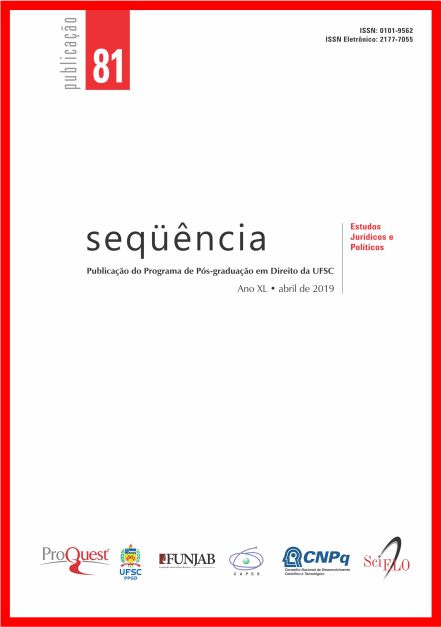Os Mecanismos de Indução ao Cumprimento do Direito Internacional à Luz da Teoria Realista das Relações Internacionais
DOI:
https://doi.org/10.5007/2177-7055.2019v40n81p181Resumo
Há uma carência de pesquisa acadêmica sobre o direito internacional com ferramentas metodológicas interdisciplinares, particularmente sobre o cumprimento do direito internacional a partir das teorias das relações internacionais. Diante disso, buscou-se analisar o fenômeno do cumprimento do direito internacional, conforme os argumentos centrais do paradigma realista das relações internacionais. Constatou-se que, para o realismo, o cumprimento do direito internacional depende do nível de coerção de seus mecanismos determinados pelas relações de poder e pelas assimetrias das relações internacionais.Referências
ABBOTT, Kenneth W. International relations theory, international law, and the regime governing atrocities in international conflicts. Studies in Transnational Legal Policy, [S.l.], v. 36, p. 127-158, 2004.
ABBOTT, Kenneth W. Toward a richer institutionalism for international law and policy. Journal of International Law and International Relations, [S.l.], v. 1, n. 1-2, p. 9-34. 2005.
ABBOTT, Kenneth W.; SNIDAL, Duncan. Hard and soft law in international governance. International Organization, [S.l.], v. 54, p. 421-456, 2000. ACEVES, William J. Institutionalist theory and international legal scholarship. American University Journal of International Law and Policy, [S.l.], v. 12, n. 2, p. 227-266, 1997.
ALKOBY, Asher. Non-state actors and the legitimacy of international environmental law. Non-State Actors and International Law, [S.l.], v. 3, n. 1, p. 23-98, 2003.
ALKOBY, Asher. Theories of compliance with international law and challenge of cultural difference. Journal of International Law and International Relations, [S.l.], v. 4, p. 151-198, 2008.
AREND, Anthony Clark. Do legal rules matter? international law and international politics. Virginia Journal of International Law, [S.l.], v. 38, p. 107-154, 1998.
ARMSTRONG, David; FARRELL, Theo; LAMBERT, Hélène. International law and international relation. 2. ed. Cambridge: Cambridge University Press, 2012. 353 p. ARON, Raymond. Paz e guerra entre nações. Trad. Sergio Bath. Brasília, DF: Universidade de Brasília, 2002. 928 p.
BEDERMAN, David J. Constructivism, positivism, and empiricism in international law. Georgetown Law Journal, [S.l.], v. 89, n. 2, p. 469500, 2001.
BOYLE, Francis A. World politics and international law. Durham: Duke University Press, 1985. 366 p.
BRUNNÉE, Jutta; TOOPE, Stephen J. International law and constructivism: elements of an interactional theory of international law. Columbia Journal of Transnational Law, [S.l.], v. 39, n. 1, p. 19-74, 2000.
BURLEY, Anne-Marie Slaughter. International law and international relations theory: a dual agenda. American Journal of International Law, [S.l.], v. 87, n. 2, p. 205-239, 1993.
CARR, Edward Hallett. Vinte anos de crise, 1919-1939: uma introdução ao estudo das relações internacionais. Trad. Luiz Alberto Figueiredo Machado. 2. ed. Brasília, DF: Universidade de Brasília, 2001. 312 p.
COGAN, Jacob Katz. Noncompliance and the international rule of law. The Yale Journal of International Law, [S.l.], v. 31, p. 189-210. 2006.
ELVY, Stacy-Ann. Theories of state compliance with international law: assessing the african union’s ability to ensure state compliance with the african charter and constitutive act. Georgia Journal of International and Comparative Law, [S.l.], v. 41, n. 1, p. 75-156, 2012.
FRISCHMANN, Brett. A dynamic institutional theory of international law. Buffalo Law Review, [S.l.], v. 51, p. 679-809, 2003.
FRY, James D. Legitimacy push: towards a gramscian approach to international law. UCLA Journal of International Law and Foreign Affairs, [S.l.], v. 13, n. 2, p. 308-336, 2008.
GILPIN, Robert. War and change in world politics. Cambridge: Cambridge University Press, 1981. 272 p.
GINSBURG, Tom; MCADAMS, Richard H. Adjudicating in anarchy: an expressive theory of international dispute resolution. William and Mary Law Review, [S.l.], v. 45, n. 4, p. 1.229-1.340, 2004.
GINSBURG, Tom; SHAFFER, Gregory. How does international law work? what empirical research shows. Minnesota Legal Studies Research, [S.l.], Paper n. 9-54, p. 1-26, 2009.
GOLDSMITH, Jack. Sovereignty, international relations theory, and international law. Stanford Law Review, [S.l.], v. 52, p. 959-986, 2000.
GOLDSMITH, Jack; POSNER, Eric A. A theory of customary international law. The University of Chicago Law Review, [S.l.], v. 66, p. 1.113-1.211, 1999. GOODMAN, Ryan; JINKS, Derek. How to influence states: socialization and international human rights law. Duke Law Journal, [S.l.], v. 54, p. 621-704, 2004.
GOODMAN, Ryan; JINKS, Derek. Measuring the effects of human rights treaties. European Journal of International Law, [S.l.], v. 14, p. 171-183, 2003.
GOODMAN, Ryan; JINKS, Derek. Toward an institutional theory of sovereignty. Stanford Law Review, [S.l.], v. 55, n. 5, p. 1.749-1.788, 2003.
GRIECO, Joseph M. Anarchy and the limits of cooperation: a realist critique of the newest liberal institutionalism. International Organization, [S.l.], v. 42, n. 3, p. 485-507, 1988.
GUZMAN, Andrew T. A compliance-based theory of international law. California Law Review, [S.l.], v. 90, p. 1.823-1.887, 2002.
GUZMAN, Andrew T. How international law works: a rat ional choice theory. Oxford: Oxford University Press, 2008. 260 p.
HAAS, Peter M. Why comply, or some hypotheses in search of an analyst. Studies in Transnational Legal Policy, [S.l.], v. 29, p. 21-48, 1997.
HAFNER-BURTON, Emilie M.; VICTOR, David G.; LUPU, Yonatan. Political science research on international law: the state of the field. The American Journal of International Law, [S.l.], v. 106, p. 47-97, 2012.
HALLING, Matt. A law of no gods, no masters: developing and defending a participatory legal system. Hastings International and Comparative Law Review, [S.l.], v. 32, n. 1, p. 237-270, 2009.
HATHAWAY, Oona A. Between power and principle: a political theory of international law. Yale Law School Legal Scholarship Repository, [S.l.], p. 469-536, jan. 2005.
HATHAWAY, Oona A.; LAVINBUK, Ariel N. Rationalism and revisionism in international law. Harvard Law Review, [S.l.], v. 119, n. 5, p. 1.404-1.444, 2006.
HENKIN, Louis. How nations behave: law and foreign policy. 2. ed. New York: Columbia University, 1979. 400 p.
HOBBES, Thomas. Leviatã: ou, a matéria, forma e poder de um Estado eclesiástico e civil. Trad. Rosinna D’Angina. 2. ed. São Paulo: Ícone, 2003. 487 p.
IRISH, Adam; KU, Charlotte; DIEHL, Paul F. Bridging the international law-international relations divide: taking stock of progress. Georgia Journal of International and Comparative Law, [S.l.], v. 41, n. 2, p. 357-388, 2013.
JACOBSON, Harold K. The global system and the realization of human dignity and justice. International Studies Quarterly, [S.l.], v. 26, n. 3, p. 315-332, 1982.
JEPPERSON, Ronald L.; WENDT, Alexander; KATZENSTEIN, Peter J. Norms, identity, and culture in national security. In: KATZENSTEIN, Peter J. (coord.). The culture of national security. New York: Columbia University Press, 1996. p. 33-75.
KATZENSTEIN, Peter J.; KEOHANE, Robert O.; KRASNER, Stephen D. International organization and the study of world politics. International Organization, [S.l.], v. 52, n. 4, p. 645-685, 1998.
KENNAN, George Frost. American diplomacy: 1900-1950. New York: Mentor, 1951. 144 p.
KEOHANE, Robert O. Compliance with international commitments: politics within a framework of law. American Society of International Law Proceedings, [S.l.], v. 86, p. 176-179, 1992.
KEOHANE, Robert O. International institutions: two approaches. International Studies Quarterly, [S.l.], v. 32, n. 4, p. 379-396, 1988.
KEOHANE, Robert O. International relations and international law: interests reputation, institutions. American Society of International Law Proceedings, [S.l.], v. 93, p. 375-379, 1999.
KINGSBURY, Benedict. The concept of compliance as a function of competing conceptions of international law. Michigan Journal of International Law, [S.l.], v. 19, p. 345-372, 1998.
KRASNER, Stephen D. International law and international relations: together, apart, together? Chicago Journal of International Law, [S.l.], v. 1, n. 1, p. 93-100, 2000.
KRASNER, Stephen D. Structural causes and regime consequences: regimes as intervening variables. International Organization, [S.l.], v. 36, n. 2, p. 185-205, 1982.
KREPS, Sarah Elizabeth; AREND, Anthony Clark. Why states follow the rules: toward a positional theory of adherence to international legal Duke Journal of Comparative & International Law, [S.l.], v. 16, n. 2, p. 331-411, 2006.
LEVIT, Janet Koven. The dynamics of international trade finance regulation: the arrangement on officially supported export credits. Harvard International Law Journal, [S.l.], v. 45, n. 1, p. 65-181, 2004.
MAQUIAVEL, Nicolau. O príncipe. Trad. Maria Júlia Goldwasser. 4. ed. São Paulo: Martins Fontes, 2011. 197p.
MOORE, John Norton. Enhancing compliance with international law: a neglected remedy. Virginia Journal of International Law, [S.l.], v. 39, n. 4, p. 881-1.016, 1999.
MORGENTHAU, Hans Joachim. A política entre as nações: a luta pelo poder e pela paz. Trad. Oswaldo Biato. Brasília, DF: Universidade de Brasília, 2003. 1.093 p.
MUSHKAT, Roda. Compliance with international environmental regimes: chinese lessons. William & Mary Environmental Law and Policy Review, [S.l.], v. 34, n. 2, p. 493-542, 2010.
PURVIS, Nigel. Critical legal studies in public international law. Harvard International Law Journal, [S.l.], v. 32, n. 1, p. 81-128, 1991.
RATNER, Steven R. Does international law matter in preventing ethnic conflict? New York University Journal of International Law and Politic, [S.l.], v. 32, p. 591-698, 2000.
RAUSTIALA, Kal. The architecture of international cooperation: transgovernmental networks and the future of international law. Virginia Journal of International Law, [S.l.], v. 43, n. 1, p. 1-92, 2002.
ROCHESTER, J. Martin. The rise and fall of international organization as a field of study. International Organization, [S.l.], v. 40, n. 4, p. 777813, 1986. ROEMER, A. Introducción al análisis económico del derecho. 2. ed. México: ITAM, 2000.
SHANY, Yuval. Assessing the effectiveness of international courts: a goal-based approach. American Journal of International Law, [S.l.], v. 106, n. 2, p. 225-270, 2012.
SIMMONS, Beth A. Compliance with international agreements. Annual Reviews of Political Science, [S.l.], v. 1, p. 75-93, 1998.
SLAUGHTER, Anne-Marie. International law in a world of liberal states. European Journal of International Law, [S.l.], v. 6, n. 4, p. 503-538, 1995.
SORNARAJAH, M. Power and justice in international law. Singapore Journal of International & Comparative Law, [S.l.], v. 1, n. 1, p. 2868, 1997. SPIRO, Peter J. Globalization, international law, and the academy. New York University Journal of International Law and Politics, [S.l.], v. 32, n. 2, p. 567-590, 2000.
STEINBERG, Richard H. In the shadow of law or power? Consensusbased bargaining and outcomes in the GATT/WTO. International Organization, [S.l.], v. 56, n. 2, p. 339-374, 2002.
STRANGE, Susan. Cave! Hic dragones: a critique of regime analysis. International Organization, [S.l.], v. 36, n. 2, p. 479-496, 1982.
TUCÍDIDES. História da guerra do Peloponeso. Trad. Mário da Gama Kury. Brasília, DF; São Paulo: Universidade de Brasília; Imprensa Oficial de São Paulo: Instituto de Pesquisa de Relações Internacionais, 2001. 582 p.
WALTZ, Kenneth Neal. Theory of international politics. Boston, Mass.: Mcgraw-Hill, 1979. 251 p. WATTS, Sean. Reciprocity and the law of war. Harvard International Law Journal, [S.l.], v. 50, n. 2, p. 365-434, 2009.
YOUNG, Oran R. International regimes: toward a new theory of institutions. World Politics, [S.l.], v. 39, n. 1, p. 104-122, 1986. ZURN, Michael. Introduction: law and compliance at different levels. In: ZURN, Michael; JOERGES, Christian (coord.). Law and governance
in postnational Europe: compliance beyond the nation-state. New York: Cambridge University Press, 2005. p. 1-39.





















